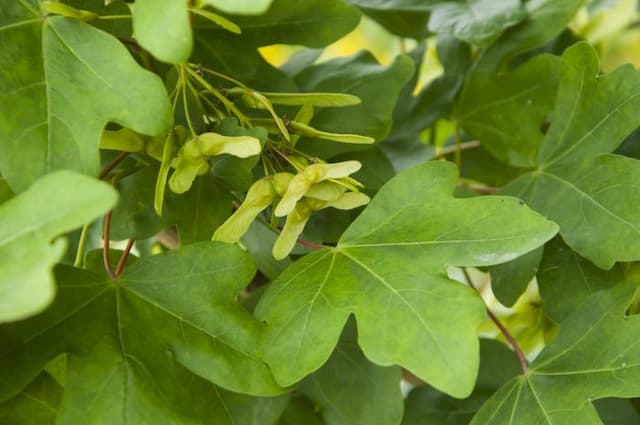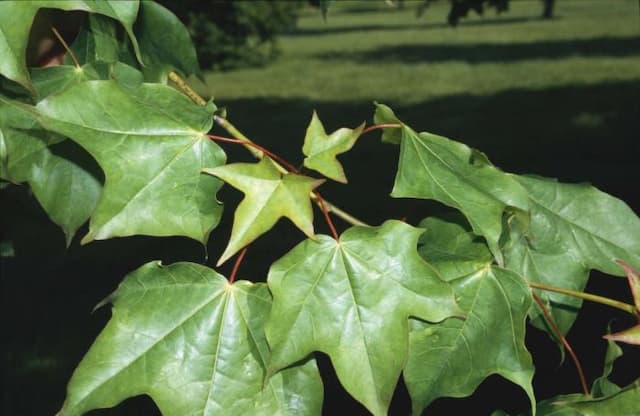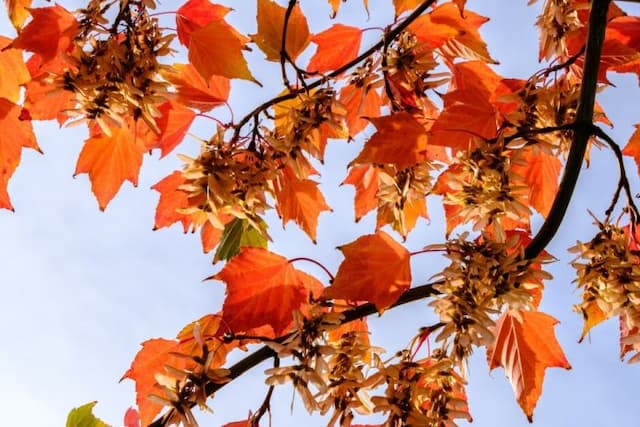Queen Elizabeth Hedge Maple Acer campestre 'Queen Elizabeth'

ABOUT
The Acer campestre 'Queen Elizabeth', commonly known as the Queen Elizabeth hedge maple, is a cultivar celebrated for its distinctive visual appeal. This plant typically displays a compact and rounded form, which makes it an excellent choice for landscapes seeking a structured appearance. Its leaves emerge with a fresh green hue that intensifies as they mature. The foliage might show subtle color shifts with the changing seasons, transitioning to lovely shades of yellow or gold in the fall, which provides a visual reminder of the autumnal transformation. The bark of the Queen Elizabeth hedge maple provides textural interest. It can be described as relatively smooth with a greyish tone, becoming slightly furrowed as the plant ages. Twigs are slender, and their color can range from green to brown, which may stand in pleasant contrast to the leaves. One of the most striking features of this hedge maple is its leaves. They are typically comprised of five lobes with smooth edges, imbuing them with a classic maple silhouette. This lobe structure gives each leaf a hand-like shape that is both recognizable and aesthetically pleasing. The veins within the leaves are well defined, creating a pattern that highlights the leaf's structure. Flowers and seeds are part of its ornamental value, although they are typically not the main feature homeowners seek with this cultivar. Nevertheless, the small, inconspicuous flowers add a subtle charm in the spring, while the seeds may attract wildlife and provide additional seasonal interest. Overall, the Acer campestre 'Queen Elizabeth' is valued for its visual qualities, including its leaf shape, seasonal color changes, and compact growth habit, which lends itself to use in a variety of landscape design strategies.
About this plant
 Names
NamesFamily
Sapindaceae
Synonyms
Queen Elizabeth Hedge Maple, Queen Elizabeth Field Maple
Common names
Acer campestre 'Queen Elizabeth'.
 Toxicity
ToxicityTo humans
The Acer campestre, commonly known as Hedge Maple, is not typically known to be toxic to humans. Generally, ingestion of any part of the Hedge Maple does not cause serious symptoms of poisoning in humans and is considered safe from a toxicity standpoint.
To pets
The Acer campestre, or Hedge Maple, is also not known to be toxic to pets. Ingestion of its parts is not typically associated with poisoning, and pets who consume this plant are not expected to experience serious health consequences due to its toxicity, as it is considered to be non-toxic to animals as well.
 Characteristics
CharacteristicsLife cycle
Perennials
Foliage type
Deciduous
Color of leaves
Green
Flower color
Yellow-green
Height
32 feet (9.75 meters)
Spread
26 feet (7.92 meters)
Plant type
Tree
Hardiness zones
5
Native area
Europe
Benefits
 General Benefits
General Benefits- Attractive foliage – The plant has beautiful deciduous leaves that change color throughout the seasons, providing visual interest.
- Drought tolerance – Once established, it can survive with less water, making it suitable for drier climates or water-conserving gardens.
- Wildlife habitat – Provides food and shelter for various bird species, beneficial insects, and other wildlife.
- Compact growth – It has a smaller, more manageable size compared to other trees, making it appropriate for smaller gardens or limited spaces.
- Hardy nature – It's robust and can withstand a variety of soil types and environmental conditions.
- Low maintenance – Requires minimal pruning and care once established, saving time and effort for gardeners.
- Shade provider – Creates a cool, shaded area which can be enjoyed during warmer months or used to protect more shade-loving plants.
- Ornamental interest – With its rounded crown and dense foliage, it contributes positively to the landscape's aesthetic appeal.
- Urban tolerance – The ability to withstand pollution and confined soil conditions makes it suitable for urban and street planting.
- Seasonal interest – Generates interest across seasons with spring flowers, summer canopy, autumn color, and textured winter bark.
 Medical Properties
Medical PropertiesThis plant is not used for medical purposes.
 Air-purifying Qualities
Air-purifying QualitiesThis plant is not specifically known for air purifying qualities.
 Other Uses
Other Uses- Acer campestre, commonly known as Field Maple, can be used in joinery for its hard and dense wood, making it suitable for finely crafted furniture or detailed woodworking projects.
- In landscaping, the 'Queen Elizabeth' variety of Field Maple is often planted as a hedge due to its dense foliage and ability to withstand pruning and shaping.
- Its wood is also valued for making musical instruments, such as woodwind instruments, for its resonant qualities.
- Field Maple wood burns slowly and with little smoke, making it an excellent choice for firewood and charcoal production.
- The tree's sap can be used to make a syrup similar to that of the sugar maple, although it is less sweet and more labor-intensive to produce.
- Artists may use the fine-grained wood of the Field Maple for carving sculptures and decorative objects.
- The dense canopy of the Field Maple can provide a natural sound barrier, making it a strategic choice for urban areas to help reduce noise pollution.
- Due to its tolerance for tough urban conditions, the Field Maple is sometimes planted to aid in urban wildlife conservation by providing habitat for birds and insects.
- Bonsai enthusiasts may use Field Maple to create miniature landscapes due to its attractive foliage and responsiveness to pruning.
- Dyes can be produced from the leaves and bark of the Field Maple, providing natural colorants for textiles and crafts.
Interesting Facts
 Feng Shui
Feng ShuiThe Hedge Maple is not used in Feng Shui practice.
 Zodiac Sign Compitability
Zodiac Sign CompitabilityThe Hedge Maple is not used in astrology practice.
 Plant Symbolism
Plant Symbolism- Strength - The Acer campestre, commonly known as hedge maple, is known for its sturdy wood, often used in making furniture, which symbolizes strength and endurance.
- Versatility - As a species that can thrive in a variety of soils and conditions, the hedge maple represents adaptability and flexibility in life.
- Growth - With its expansive canopy, the hedge maple signifies personal growth and expansion of one's own boundaries.
- Longevity - Hedge maples can live for many years, symbolizing a long life filled with experiences and wisdom.
- Protection - Because of its dense foliage and use as a windbreak and privacy screen, the hedge maple symbolizes shelter and protection.
 Water
WaterThe Queen Elizabeth Hedge Maple should be watered deeply and thoroughly, allowing the soil to dry slightly between waterings. Typically, watering once a week with 1 to 2 gallons of water is suitable for young trees, while established trees may require less frequent watering, depending on the weather conditions. During hot and dry spells, increase watering frequency to prevent stress. Over the winter months, you can reduce watering since the tree will be dormant. Always check the soil moisture before watering to avoid over-watering, which can lead to root rot.
 Light
LightThe Queen Elizabeth Hedge Maple thrives best in full sun to partial shade. It's recommended to plant it in a spot where it will receive at least 4 to 6 hours of direct sunlight daily. While it can tolerate some shade, too much will affect its growth and foliage density. An ideal location would be one with morning sun and some afternoon shade, especially in hotter climates.
 Temperature
TemperatureThe Queen Elizabeth Hedge Maple is quite adaptable and can withstand a wide range of temperatures, but it prefers a temperate climate for optimal growth. This tree can survive minimum winter temperatures down to -30°F, but the ideal growing range is between 50°F and 80°F. During extreme heat, supplemental watering may be necessary to keep the tree healthy.
 Pruning
PruningThe Queen Elizabeth Hedge Maple should be pruned to maintain its shape and health. The best time for pruning is during the late winter or early spring before new growth starts. Pruning annually or biennially will help to remove dead or crossing branches and encourage denser foliage. Pruning also allows you to shape the tree and control its size.
 Cleaning
CleaningAs needed
 Soil
SoilThe Hedge maple, Acer campestre 'Queen Elizabeth', thrives best in well-draining, fertile soil with a pH range of 6.0 to 7.5. A good soil mix for this plant might include loamy garden soil, compost, and coarse sand or perlite to improve drainage. Mulching can help retain moisture and provide nutrients.
 Repotting
RepottingThe Hedge maple should be repotted sparingly as it prefers to remain undisturbed. Young trees may need repotting every 2-3 years until they establish, but mature specimens will rarely require repotting.
 Humidity & Misting
Humidity & MistingThe Hedge maple is adaptable to a wide range of humidity levels and does not require high humidity to thrive. Average ambient humidity levels found in outdoor environments are sufficient.
 Suitable locations
Suitable locationsIndoor
Ensure bright, indirect light and room to grow.
Outdoor
Plant in sun to partial shade, protect from strong winds.
Hardiness zone
5-8 USDA
 Life cycle
Life cycleThe 'Queen Elizabeth' hedge maple, commonly known as Acer campestre 'Queen Elizabeth', begins its life as a seed, which, after dormancy and with the right conditions, germinates in the spring. The seedling then grows into a young sapling, establishing a basic root system and stem structure. As it matures into a juvenile tree, it develops a more extensive root system, foliage, and branches. Upon reaching maturity, the 'Queen Elizabeth' hedge maple produces flowers that, upon pollination, set seeds, thus completing the cycle of reproduction. The mature tree continues to produce seeds annually, grow in size, and may live for several decades. As an ornamental cultivar, its life cycle is often influenced by human care practices, such as pruning, which can impact its growth and longevity.
 Propogation
PropogationPropogation time
Early Spring
Propogation: The Acer campestre 'Queen Elizabeth', commonly known as the Queen Elizabeth Hedge Maple, is primarily propagated through seed or by grafting. The most popular method for propagating the Queen Elizabeth Hedge Maple is grafting, particularly because it maintains the specific characteristics of this cultivar. This propagation technique is typically performed in late winter or early spring before the plant breaks dormancy. In grafting, a piece of the Queen Elizabeth Hedge Maple, known as the scion, is joined to a rootstock of a common maple species. The scion, which is usually about 6 inches (approximately 15 centimeters) in length, contains a few buds and is meticulously joined to a similarly sized cut in the rootstock. The join is then sealed with grafting tape or wax to prevent dessication and infection while the graft union heals, a process that can take several weeks to months depending on growing conditions. Proper aftercare, including a stable environment and adequate hydration, is vital for the successful establishment of the grafted plant.






![Freeman maple [Autumn Blaze]](/_next/image?url=https%3A%2F%2Fplants-admin.emdemapps.com%2Fimages%2Fplants%2F%2Fimages%2F604b575b84d87.png&w=640&q=75)


